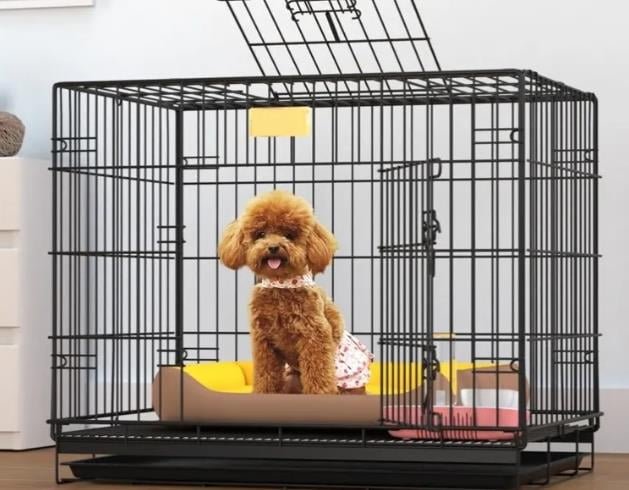
Essential Tips for Crate Training a Puppy
Introduction to Crate Training
Crate training a puppy can be a valuable method for both you and your pet. It provides your puppy with a safe and comfortable space while helping to mitigate behavioral issues. This guide will cover essential tips for successfully crate training your new furry friend.
Choosing the Right Crate
The first step in crate training is selecting the appropriate crate. Consider the size of your puppy and choose a crate that allows them to stand, turn around, and lie down comfortably. It’s important that the crate is not too large, as this might encourage your puppy to use one end as a bathroom area. A properly sized crate will help your puppy feel secure.
Introducing the Crate
Introduce the crate gradually to ensure your puppy feels comfortable. Start by placing the crate in a common area of your home and keep the door open. Encourage your puppy to explore the crate by placing treats, toys, and soft bedding inside. Allow your puppy to enter and exit the crate freely without forcing them.
Establishing a Routine
Consistency is key when crate training a puppy. Establish a routine by feeding your puppy their meals inside the crate and creating a schedule for crate time. Begin with short periods and gradually increase the duration as your puppy becomes more accustomed to the crate. Make sure to provide bathroom breaks and playtime outside the crate to keep your puppy happy and healthy.
Positive Reinforcement
Use positive reinforcement techniques to make crate training a positive experience. Praise your puppy and offer treats when they enter the crate willingly. Avoid using the crate as a form of punishment, as this can create negative associations. Patience and positive reinforcement will lead to a successful crate training experience.
American Dingo animal behavior Budget Tips canine behavior Canine Care Canine Health DIY pet projects dog behavior Dog Breeds dog care Dog Care Tips dog exercise Dog Food Dog Grooming dog health Dog Measurement dog nutrition dog ownership dog potty area Dog Training Dog Wound Care Family Pets Hunting Dogs lipomas in dogs newborn puppy care obedience training outdoor pet care Pet Care Pet Care Tips Pet Health Pet Loss Pet Safety pet tips pet training Positive Reinforcement Potty Training Puppy Care puppy health Puppy Training Rabies in Dogs Temperature Monitoring Training Tips veterinary advice Veterinary Care Veterinary Tips
-
 Dog Breeding Age Guide 2025: Optimal Timing for Females & Males (+ Vet-Approved Risks)
4 views
Dog Breeding Age Guide 2025: Optimal Timing for Females & Males (+ Vet-Approved Risks)
4 views -
 How to Identify an Australian Stumpy Tail Cattle Dog
3 views
How to Identify an Australian Stumpy Tail Cattle Dog
3 views -
 13 Must-Know 2025 Pet Hotel Stats: Market Boom, Profit Margins & Future Trends Revealed
2 views
13 Must-Know 2025 Pet Hotel Stats: Market Boom, Profit Margins & Future Trends Revealed
2 views -
 Labradoodle vs. Cockapoo: Understanding the Differences
2 views
Labradoodle vs. Cockapoo: Understanding the Differences
2 views -
 How to Teach Your Dog to Use the Restroom at a Designated Location
2 views
How to Teach Your Dog to Use the Restroom at a Designated Location
2 views -
 Daylight Saving Time & Dogs: Vet-Reviewed Effects on Canine Sleep, Behavior & Adjustment Tips
2 views
Daylight Saving Time & Dogs: Vet-Reviewed Effects on Canine Sleep, Behavior & Adjustment Tips
2 views -
 Dog Drug Testing: Vet-Approved Methods for Urine vs. Hair Tests & How to Ensure Accurate Results
2 views
Dog Drug Testing: Vet-Approved Methods for Urine vs. Hair Tests & How to Ensure Accurate Results
2 views -
 What It’s Really Like to Travel with a Guide Dog
1 view
What It’s Really Like to Travel with a Guide Dog
1 view -
 How to Measure Your Dog’s Height Correctly
1 view
How to Measure Your Dog’s Height Correctly
1 view -
 Pitbull Allergies: 7 Vet-Approved Signs, Treatments & How to Protect Your Dog (2025 Guide)
1 view
Pitbull Allergies: 7 Vet-Approved Signs, Treatments & How to Protect Your Dog (2025 Guide)
1 view










Leave a Reply
You must be logged in to post a comment.